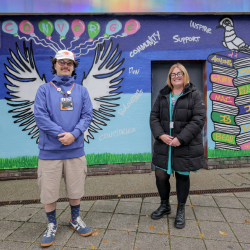-
Study
-
Quick Links
- Open Days & Events
- Real-World Learning
- Unlock Your Potential
- Tuition Fees, Funding & Scholarships
- Real World Learning
-
Undergraduate
- Application Guides
- UCAS Exhibitions
- Extended Degrees
- School & College Outreach
- Information for Parents
-
Postgraduate
- Application Guide
- Postgraduate Research Degrees
- Flexible Learning
- Change Direction
- Register your Interest
-
Student Life
- Students' Union
- The Hub - Student Blog
- Accommodation
- Northumbria Sport
- Support for Students
-
Learning Experience
- Real-World Learning
- Research-enriched learning
- Graduate Futures
- The Business Clinic
- Study Abroad
-
-
International
International
Northumbria’s global footprint touches every continent across the world, through our global partnerships across 17 institutions in 10 countries, to our 277,000 strong alumni community and 150 recruitment partners – we prepare our students for the challenges of tomorrow. Discover more about how to join Northumbria’s global family or our partnerships.
View our Global Footprint-
Quick Links
- Course Search
- Undergraduate Study
- Postgraduate Study
- Information for Parents
- London Campus
- Northumbria Pathway
- Cost of Living
- Sign up for Information
-
International Students
- Information for International Students
- Northumbria and your Country
- International Events
- Application Guide
- Entry Requirements and Education Country Agents
- Global Offices
- English Requirements
- English Language Centre
- International student support
- Cost of Living
-
International Fees and Funding
- International Undergraduate Fees
- International Undergraduate Funding
- International Masters Fees
- International Masters Funding
- International Postgraduate Research Fees
- International Postgraduate Research Funding
- Useful Financial Information
-
International Partners
- Agent and Representatives Network
- Global Partnerships
- Global Community
-
International Mobility
- Study Abroad
- Information for Incoming Exchange Students
-
-
Business
Business
The world is changing faster than ever before. The future is there to be won by organisations who find ways to turn today's possibilities into tomorrows competitive edge. In a connected world, collaboration can be the key to success.
More on our Business Services-
Business Quick Links
- Contact Us
- Business Events
- Research and Consultancy
- Education and Training
- Workforce Development Courses
- Join our mailing list
-
Education and Training
- Higher and Degree Apprenticeships
- Continuing Professional Development
- Apprenticeship Fees & Funding
- Apprenticeship FAQs
- How to Develop an Apprentice
- Apprenticeship Vacancies
- Enquire Now
-
Research and Consultancy
- Space
- Energy
- AI and Tech
- CHASE: Centre for Health and Social Equity
- NESST
-
-
Research
Research
Northumbria is a research-rich, business-focused, professional university with a global reputation for academic quality. We conduct ground-breaking research that is responsive to the science & technology, health & well being, economic and social and arts & cultural needs for the communities
Discover more about our Research-
Quick Links
- Research Peaks of Excellence
- Academic Departments
- Research Staff
- Postgraduate Research Studentships
- Research Events
-
Research at Northumbria
- Interdisciplinary Research Themes
- Research Impact
- REF
- Partners and Collaborators
-
Support for Researchers
- Research and Innovation Services Staff
- Researcher Development and Training
- Ethics, Integrity, and Trusted Research
- University Library
- Vice Chancellors Fellows
-
Research Degrees
- Postgraduate Research Overview
- Doctoral Training Partnerships and Centres
- Academic Departments
-
Research Culture
- Research Culture
- Research Culture Action Plan
- Concordats and Commitments
-
-
About Us
-
About Northumbria
- Our Strategy
- Our Staff
- Our Schools
- Place and Partnerships
- Leadership & Governance
- University Services
- Northumbria History
- Contact us
- Online Shop
-
-
Alumni
Alumni
Northumbria University is renowned for the calibre of its business-ready graduates. Our alumni network has over 253,000 graduates based in 178 countries worldwide in a range of sectors, our alumni are making a real impact on the world.
Our Alumni - Work For Us
Andrew Ross, Graduate Tutor and Lecturer in Film at Northumbria University, discusses how Harley Quinn is not just a side-kick to The Joker, but is now a multi-platform anti-hero.
The joke’s on Batman this year. Fans of the Caped Crusader usually celebrate Batman Day on September 23, but this year his thunder has been stolen by a young woman wielding a giant mallet and wearing a broad grin. On September 11, Harley Quinn turns 25 years old – and the former psychiatrist who turned to the dark side in 1992 as a sidekick to The Joker celebrates her silver anniversary as a fully rounded DC Comics multi-platform villainess.
But who is Harley Quinn – and why is a relative newcomer being granted a privilege usually afforded to the most celebrated of DC’s comic book stable? Simply put, she is a phenomenon who, since beginning life as a background stooge, has routinely matched, and occasionally outsold, the publisher’s Golden Age trinity of Batman, Superman and Wonder Woman to become the official fourth pillar of DC.
But the character’s significance reaches far beyond the printed page. Harley Quinn’s success highlights that agile consumer content is not necessarily based upon genre or legacy – but upon fluidity of content. For her audience, Harley Quinn combines the pleasures of narrative with those of participation – in other words, she is not merely a comic book character to consume passively. She is an experience.
Quinn begins
The story begins with a party. It is 1992 and Paul Dini – a screenwriter for Batman the Animated Series – is devising a scene in which a villain needs to deliver a giant cake to Commissioner Gordon in which lurks The Joker. He invents an exotic accomplice to perform the act: Harley Quinn. And so, a star is born.
A baby-voiced moll in a black and red jester’s costume, Harley Quinn may look like a clown – but she kicks like a mule and, when cornered by Batman, pulls a knife when the hero’s back is turned. More vicious than femme fatales Catwoman and Poison Ivy, Harley Quinn is also revealed in time to be something that they are not – a victim who wants out.
Mad Love, a non canonical spin-off comic from the animated series, was the first to relate the story of how infatuated psychiatrist Harleen Quinzel became seduced by the incarcerated Joker into helping him escape, only to find herself trapped in the prison of an abusive relationship ever since.
A unique example of a key Batman storyline which originated outside the comic book canon, Mad Love’s controversial influence spread so widely across multiple platforms (the animated series, comic books, the Arkham Asylum videogames, the hit film Suicide Squad) that it quickly became embedded into the fabric of the DC multiverse.
But while containing the root of Harley Quinn’s appeal, Mad Love also exposes her key difference: Harley Quinn is not a comic book character at all, she is a television one – and her relationship with the Joker is not one defined by the dramatic tensions of crime fiction but a twisted version of the “Will they? Won’t they?” plot line seen across soap opera and romantic comedies.
Her unusual origin on screen therefore meant that when Harley Quinn and her backstory became eventually absorbed by the main comic book series, tropes of TV melodrama and sitcom flowed into the DC canon – and with them entirely different audience methods of consuming content.
Comic book chameleon
My research investigates the construction of media narratives as vehicles for fulfilling audience need – and when examining the Harley Quinn story experience I was struck by how multivalent the character actually is.
While the values of stable mates Superman, Batman and Wonder Woman were codified within a few appearances, Harley Quinn can appear to be in flux 25 years on. Pick up a Batman comic in the 1940s and one from the 1980s and the values of the character remain the same with only the cultural prism through which the author views those values having changed. But over the last year alone, there have been at least six different versions of the Harley Quinn character presented to the audience across comic books, video games and film with almost no continuity of tone, content or genre between them.
This could be an indicator of trouble for a property – how can an audience make sense of the various texts if they all clamour for attention with different signals simultaneously? But it appears that mutability for Harley Quinn is the essence of her popularity. While the rest of the DC canon remain shackled to their comic book roots, and therefore can only appear as either straightlaced or parodic, Harley Quinn is a transferable property created beyond the page and able to be moulded to whatever genre or tone the creators and the audience desire.
Best friend gone bad
In the most telling storyline of recent times, Harley Quinn happens upon the amnesiac super-heroine Power Girl and pretends to be her sidekick for no other apparent reward than the opportunity for a fresh start. And, although from her very first appearances in the animated series, Harley Quinn is someone who has always been trying to escape her past, the Power Girl storyline illustrates that the character also has the self awareness to understand that this task is Sisyphean.
Super heroes such as Power Girl may deliver a vicarious thrill of empowerment to the audience but they are also untouchable paragons of virtue. Harley Quinn’s potency, is her ability to reach out to the audience and say: “It’s ok – I’m a mess, too.” Not an idol, but a friend.
Harley Quinn’s story may have begun with her breaking into a party, but I believe the Harley Quinn experience is a party to which we are all invited – a party which delivers a sense of belonging and an tragicomic acceptance that we are all at the whim of the fates together. The Justice League are heroes but they are also elitists who sit on a pedestal. Harley Quinn is a killer and accomplice to unspeakable deeds – but at least she’s one of us.
This article was originally published on The Conversation. To read the article click here
News
- First cohort of Civil Engineering Degree Apprentices graduate from Northumbria
- Venice Biennale Fellowship
- Northumbria expands results day support for students
- Northumbria academic recognised in the British Forces in Business Awards 2025
- £1.2m grant extends research into the benefits of breast milk for premature babies
- Northumbria graduate entrepreneur takes the AI industry by storm
- Study identifies attitudes towards personal data processing for national security
- Lifetime Brands brings student design concept to life
- New study reveals Arabia’s ‘green past’ over the last 8 million years
- How evaluation can reform health and social care services
- Researchers embark on a project to further explore the experiences of children from military families
- Northumbria University's pioneering event series returns with insights on experiential and simulated learning
- Support for doctoral students to explore the experiences of women who have been in prison
- Funding boost to transform breastfeeding education and practice
- A new brand of coffee culture takes hold in the North East
- BBRSC awards £6m of funding for North East Bioscience Doctoral Students
- £3m funding to evaluate health and social care improvements
- Balfour Beatty apprentices graduate from Northumbria University
- Long COVID research team wins global award
- Northumbria researchers lead discussions at NIHR event on multiple and complex needs
- Healthcare training facility opens to support delivery of new T-level course
- Young people praise Northumbria University for delivery of HAF Plus pilot
- Nursing academics co-produce new play with Alphabetti Theatre
- Research project to explore the experiences of young people from military families
- Academy of Social Sciences welcomes two Northumbria Professors to its Fellowship
- Northumbria University set to host the Royal College of Nursings International Nursing Research Conference 2024
- 2.5m Award Funds Project To Encourage More People Into Health Research Careers
- Advice available for students ahead of A-level results day
- Teaching excellence recognised with two national awards
- Northumbria law student crowned first Apprentice of the Year for the region
- Northumbria University launches summer activities to support delivery of Holiday Activities and Food programme
- UK health leader receives honorary degree from Northumbria University
- Use of AI in diabetes education achieves national recognition
- Research animation explores first-hand experiences of receiving online support for eating disorders
- Careers event supports graduate employment opportunities
- Northumbria University announces £50m space skills, research and development centre set to transform the UK space industry
- The American Academy of Nursing honours Northumbria Professor with fellowship
- New report calls for more support for schools to improve health and wellbeing in children and young people
- AI experts explore the ethical use of video technology to support patients at risk of falls
- British Council Fellows selected from Northumbria University for Venice Biennale
- Prestigious nomination for Northumbria cyber security students
- Aspiring Architect wins prestigious industry awards
- Lottery funding announced to support mental health through creative education
- Early intervention can reduce food insecurity among military veterans
- Researching ethical review to support Responsible AI in Policing
- Northumbria named Best Design School at showcase New York Show
- North East universities working together
- Polar ice sheet melting records have toppled during the past decade
- Beyond Sustainability
- Brewing success: research reveals pandemic key learnings for future growth in craft beer industry
- City's universities among UK best
- Famous faces prepare to take to the stage to bring a research-based performance to life
- Insights into British and other immigrant sailors in the US Navy
- International appointment for law academic
- Lockdown hobby inspires award-winning business launch for Northumbria student
- Lasting tribute to Newcastle’s original feminist
- Outstanding service of Northumbria Professor recognised with international award
- Northumbria academics support teenagers to take the lead in wellbeing research
- Northumbria University becomes UK's first home of world-leading spectrometer
- Northumbria's Vice-Chancellor and Chief Executive to step down
- Out of this world experience for budding space scientists
- Northumbria engineering graduate named as one of the top 50 women in the industry
- Northumbria University signs up to sustainable fashion pledge
- Northumbria demonstrates commitment to mental health by joining Mental Health Charter Programme
- Virtual reality tool that helps people to assess household carbon emissions to go on display at COP26
- EXPERT COMMENT: Why thieves using e-scooters are targeting farms to steal £3,000 quad bikes, and what farmers can do to prevent it
- Exhibition of lecturer’s woodwork will help visitors reimagine Roman life along Hadrian’s Wall
- Students reimagine food economy at international Biodesign Challenge Summit
- Northumbria storms Blackboard Catalyst Awards
- Breaking news: Northumbria’s Spring/Summer Newspaper is here!
- UK’s first ever nursing degree apprentices graduate and join the frontline
- Massive decrease in fruit and vegetable intake reported by children receiving free school meals following lockdown
- Northumbria awards honorary degrees at University’s latest congregations
Latest News and Features

Northumbria expert delivers training to help address victim-blaming language
A Northumbria University academic is leading pioneering training to support police forces across…

Northumbria University launches national AI challenge inviting young people to imagine a hopeful future
Northumbria University has launched the Hopeful Futures AI Challenge, a groundbreaking national…

Student volunteering partnership expands following five years of community impact
Following the success of a Law in the Community project, Northumbria University is expanding…

Funding awarded for innovative space technology projects
The North East Space Communications Accelerator (NESCA) has successfully awarded its first…

First cohort of Civil Engineering Degree Apprentices graduate from Northumbria
The inaugural cohort of Civil Engineering degree apprentices have graduated from Northumbria…

Global report on volunteer measurement supported by Northumbria researchers is launched
One year after Northumbria University was announced as the lead research partner on the 2026…

Space sector growth in the UK under spotlight at major industry event
The role the space sector is playing in driving economic growth in the UK was highlighted this…

Northumbria student's street art course results in striking campus mural
A Northumbria University student has designed and delivered his own course in street art, culminating…
Upcoming events

Collaborating for Capability: Shaping the Future of Supply Chain Talent
City Campus East, Northumbria University CCE1-403
-

Archives to Action: Historical Evidence for Policy Reform
The Great Hall
-

Viruses of Microbes-UK (VoM-UK) Conference 2026
Northumbria University

Commercialising SHAPE Innovations and Impact
Northumbria University
-
